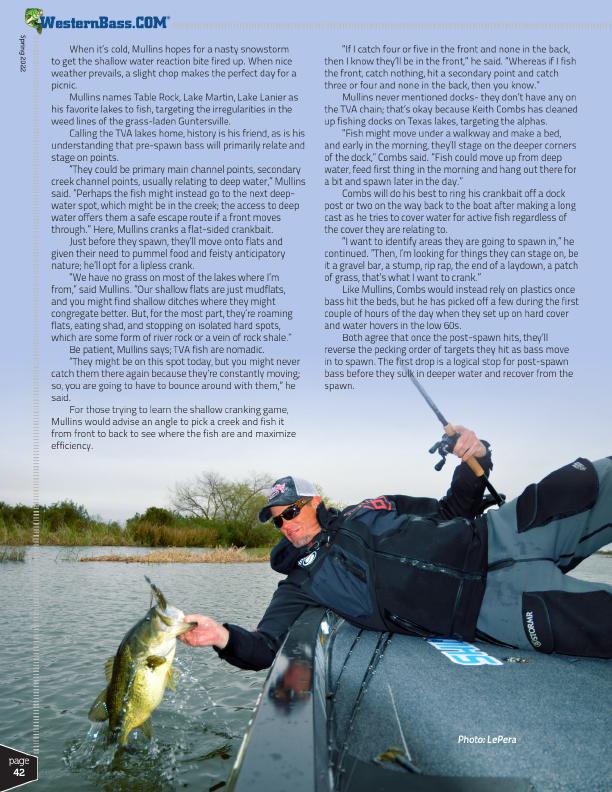
Spring 2022
®
When it’s cold, Mullins hopes for a nasty snowstorm to get the shallow water reaction bite fired up. When nice weather prevails, a slight chop makes the perfect day for a picnic.
Mullins names Table Rock, Lake Martin, Lake Lanier as his favorite lakes to fish, targeting the irregularities in the weed lines of the grass-laden Guntersville.
Calling the TVA lakes home, history is his friend, as is his understanding that pre-spawn bass will primarily relate and stage on points.
“They could be primary main channel points, secondary creek channel points, usually relating to deep water,” Mullins said. “Perhaps the fish might instead go to the next deep- water spot, which might be in the creek; the access to deep water offers them a safe escape route if a front moves through.” Here, Mullins cranks a flat-sided crankbait.
Just before they spawn, they’ll move onto flats and given their need to pummel food and feisty anticipatory nature; he’ll opt for a lipless crank.
“We have no grass on most of the lakes where I’m from,” said Mullins. “Our shallow flats are just mudflats, and you might find shallow ditches where they might congregate better. But, for the most part, they’re roaming flats, eating shad, and stopping on isolated hard spots, which are some form of river rock or a vein of rock shale.”
Be patient, Mullins says; TVA fish are nomadic.
“They might be on this spot today, but you might never catch them there again because they’re constantly moving; so, you are going to have to bounce around with them,” he said.
For those trying to learn the shallow cranking game, Mullins would advise an angle to pick a creek and fish it from front to back to see where the fish are and maximize efficiency.
“If I catch four or five in the front and none in the back, then I know they’ll be in the front,” he said. “Whereas if I fish the front, catch nothing, hit a secondary point and catch three or four and none in the back, then you know.”
Mullins never mentioned docks- they don’t have any on the TVA chain; that’s okay because Keith Combs has cleaned up fishing docks on Texas lakes, targeting the alphas.
“Fish might move under a walkway and make a bed, and early in the morning, they’ll stage on the deeper corners of the dock,” Combs said. “Fish could move up from deep water, feed first thing in the morning and hang out there for a bit and spawn later in the day.”
Combs will do his best to ring his crankbait off a dock post or two on the way back to the boat after making a long cast as he tries to cover water for active fish regardless of the cover they are relating to.
“I want to identify areas they are going to spawn in,” he continued. “Then, I’m looking for things they can stage on, be it a gravel bar, a stump, rip rap, the end of a laydown, a patch of grass, that’s what I want to crank.”
Like Mullins, Combs would instead rely on plastics once bass hit the beds, but he has picked off a few during the first couple of hours of the day when they set up on hard cover and water hovers in the low 60s.
Both agree that once the post-spawn hits, they’ll reverse the pecking order of targets they hit as bass move in to spawn. The first drop is a logical stop for post-spawn bass before they sulk in deeper water and recover from the spawn.
page 42
Photo: LePera